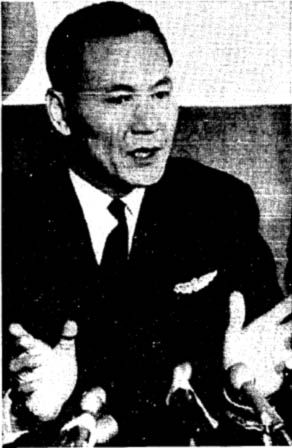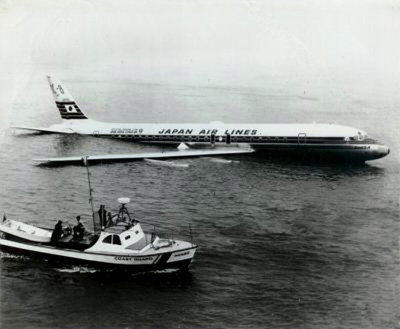Splashdown of the "Shiga"… In San Francisco Bay, California November 22, 1968  Landing Before Takeoff... Landing Before Takeoff...
Kohei Asoh, a 15 year veteran with Japan Air Lines, had served as a flight instructor for the Japanese military in World War II, and had nearly 10,000 hours of flight time - well deserving of his title of "Captain." He was experienced enough to be given the assignment of flying one of JAL's newest acquisitions - a Douglas DC-8, registered as JA8032, which had rolled off the Douglas assembly line in May of 1968, and had been in service with JAL for only six months. The DC-8, named "Shiga" by the airline, took off from Tokyo at 5:36 on the afternoon of November 22nd, 1968, bound non-stop for San Francisco (SFO). Powered by four Pratt & Whitney JT3D-3B, the eight hour flight would cross the International Date Line, so accounting for time zones and flight time, the flight was scheduled to land nearly seven hours before it took off. As Captain Asoh, and his flight crew, First Officer Joseph Hazen, flight Engineer Richard Fahning, and navigator Ichiryo Suzuki, were approaching SFO at approximately 9 AM, where the weather was reported to be "ceiling indefinite, 300 feet overcast, sky partially obscured, 3/4 mile visibility with fog". The airport's minimums at the time were, 200 feet ceiling and 1/2 mile visibility. Normal communications were established, and the crew was radar vectored to the Woodside VOR and thence to intercept the ILS for Runway 28L at San Francisco. Hazen was no stranger to skies. A Marine Corps aviator, in the summer of 1959 he joined Northwest Airlines but was furloughed a little over a year later. While in the employ of Overseas National Airways, on his two week active-duty commitment as a reservist in late 1961, he received a job offer with Air America, a then-relatively unknown airline operating in Southeastern Asia. He accepted and, over the next seven years, learned to fly nearly a dozen models of aircraft before accepting a job with Japan Airlines in July of 1968. The cabin crew, consisting of a chief purser, Kazuo Hashimoto, two stewards, and four stewardesses, prepared the passengers for landing as the plane crossed the Woodside VOR at 9:16 AM at approximately 4,000 feet and, at 9:18 AM, was cleared to descend to 2,000 feet . The flight then descended at a constant, uninterrupted rate towards the airport, lined up on the localizer approach course. On Final... The landing gear was lowered and flaps fully extended. When they broke out below the fog, the first officer called, "Breaking out of the overcast, I cannot see the runway light ." He then called out, 'We are too low - Pull up, pull up!"  Asoh applied power to the engines, and started to rotate the aircraft when water contact was made. At a speed of 137 knots, the right main gear hit the water first, followed immediately by the left gear striking. Then, the airplane reportedly made a slow turn to the left, and settled in the shallow waters about 500 yards from the Coyote Point Yacht Harbor, and two and a half miles short of runway 28L, at 9:24 in the morning. An eyewitness, Tom Martin of Menlo Park, told newsreporters of the time, “I heard the plane very low, coming in. I looked up and there it was, splashing down, just beautifully.” After the plane came to rest, the flight crew evacuated the aircraft, placing the passengers in life rafts. Hazen launched off the starboard wing when, a few moments later, a voice came out of the fog. "Ahoy, there, toss me a line and I'll tow you in." Nearby, Jack Chambers, an off-duty Captain for Western Airlines, was fishing in the bay. Hazen tossed him a line, but his little flat bottom boat with a small motor could not tow the fully-laden life rafts. Chambers offered some adult refreshments to those in the raft, to which some of the passengers obliged. At the same time, County Park Ranger Doug Lakey was in the Coyote Point parking lot when the plane splashed into the bay. He heard it and immediately notified Harbormaster Art O'Leary who hurried three boats to the plane within minutes. Fire tugs also rushed to the scene to help prevent fire in case jet fuel ignited from a spark. Wet Feet... Amazingly, there were no injuries to any of the 96 passengers or 11 crew during the accident and ensuing evacuation. Assisting the speedy and safe deplaning was the crash occurred during an unusually high tide - 7 feet - compared with the typical water level of 4 feet, leading South San Francisco fire chief John Marchi to conclude the ditching "a one-in-a-million shot" as the added water provided a cushioning to the soft impact, while still being shallow enough that exit doors would remain above the water. In deeper water, Marchi surmised, the plane could have “sunk like a rock.” Seeing no panic in the startled passengers, Chief purser Hashimoto tried to make an announcement with the electrically-powered public address system after the landing, but discovered that it was without power. Hashimoto ended up shouting from the forward cabin for passengers to "Be quiet, the plane has reached the bottom of the sea. It will not sink. Do not worry, we are well-fixed for evacuation." In relative calm, the passengers and crew evacuated the waterlogged jet onto awaiting boats and liferafts. A private pilot traveling aboard, Peter Covert, exclaimed, “this was a damned good water landing. By the time we knew we were in trouble, we were safe.” Capt. Asoh was the last to leave. Two days after the crash, crews from Bigge Drayage Company and Air International Recovery hoisted the plane out of the water with large floating cranes and placed the plane on a large barge. As soon as the plane was out of the brackish water of San Francisco Bay, some 55 hours after splashdown, salvage crews started washing down the plane with fresh water to help prevent corrosion. The plane was then taken by barge to Dock 4, and towed to United Airline's maintenance base at SFO. According to the National Transportation Safety Board (NTSB), the captain said he was making a coupled approach, but because of problems with his pressure altimeter, he was relying on the more accurate radio altimeter for verification of altitude. The captain looked up expecting to be 200 feet above the water but instead was nearly in the water. He applied power but it was too late. The captain did not cross-check the raw data glide-slope signals and did not realize the ILS on-course position was far above where he was. As a result, Japan Air Lines changed their training procedures to stress command responsibilities, crew coordination and transition time for new type of aircraft. Asoh was assigned to ground operations in Tokyo as a routine retraining measure, and demoted to co-pilot. The "Asoh Defense"... The person ultimately responsible for the safe conduct of the flight, Kohei Asoh, said later that he thought he was landing at San Francisco International; instead, the plane belly-flopped into the bay several hundred yards from the runway. But he took full responsibility for the accident and refused to blame anyone else or any other circumstances. At the NTSB hearing, Capt. Asoh took the stand as first witness and supposedly said, in answer to why he had landed in the bay, "As you Americans say, I fucked up." Such a frank acceptance of blame and responsibility has come to be known as the "Asoh Defense". It has been discussed in various books such "The Abilene Paradox" by Professor Jerry Harvey, publications and in company training films. Other flight crew members, including Hazen and Fahning, had abbreviated meetings with the NTSB - in and out within five minutes. During the investigation, the subject of Pan Am Flight 6 - a Boeing 377 Stratocruiser that was forced to ditch in the Pacific Ocean near Ocean Station November on October 16, 1956, after the failure of two of its four engines - came up. One of the investigators was the nephew of that flight's Captain, Richard N. Ogg, and was curious as to which landing configuration was better for the water, gear down or gear up? Hazen replied that he thought the surface conditions of the water would be the best determinant. In the end, the NTSB determined the probable cause of the crash was, "the improper application of the prescribed procedures to execute an automatic-coupled ILS approach. This deviation from the prescribed procedures was, in part, due to a lack of familiarization and infrequent operation of the installed flight director and autopilot system." Asoh returned to flight duty with Japan Airlines after some ground schooling, and although he was demoted to First Officer, he continued flying freight until his retirement. Hazen also returned to aviation a few months later, and was promoted to Captain in May of 1969. In 1974, he upgraded to the Boeing 747, and continued to fly it until his retirement in 1994.She Flies Again... Repairs were carried out by United Air Lines on the "Shiga", and it was returned to JAL on March 31, 1969, and along with a $4 million invoice for over 52,000 man-hours of labor. JAL changed the name of the aircraft from 'Shiga' to 'Hidaka', and after a successful test flight on April 11, 1969, from San Francisco to Honolulu, the plane went back into regular service with JAL. On August 19, 1969, Hazen was flying a route check from Tokyo's Haneda Airport (HND) nonstop to San Francisco (SFO). The aircraft he flew that day: JA 8032, aka the newly-christened 'Hidaka'. That flight, too, met with misadventure as, when the Dash-8 was on final approach to runway 28L, a TWA 707 was blocking the runway near the far end, despite the control tower instructing him to expedite. Luckily, the weather was good, and Hazen's quick-thinking enabled him to make a left turn, proceed downwind and made another approach to a successful landing. The plane continued to fly for Japan Airlines for 14 more years until it was sold in March 1983 to Air ABC and reregistered as TF-BBF. In May of 1983 the plane was leased to Hamzair until December 1983 when it was returned to Air ABC. In July of 1984 it was sold to Okada Air of Nigeria and reregistered as 5N-AON. A few years later, in April of 1987, the plane was purchased by Airborne Express and reregistered as N808AX. After a second career as a express freighter for Airborne Express, years of fatigue cracks caught up with the veteran DC-8, and in December of 2001, it met its demise on the ramp at Wilmington Air Park (ILN) in Ohio, at the mercy of the salvage crews' hydraulic claws. A Repeatable Feat... On February 9th, 1982, another Japan Air Lines DC-8, Flight 350, registered as JA-8061, was on a domestic scheduled passenger flight from Fukuoka, Japan, to Tokyo's Haneda Airport when it crashed on approach into Tokyo Bay. The cause of the crash was traced to the Captain's deliberate engaging of the number 2 and 3 engine's thrust-reversers in flight, in an attempted suicide. Unfortunately, 24 passengers were killed in the ditching, and the Captain found not guilty of murder by reason of insanity. More positively, on the afternoon of January 15th, 2009, an Airbus 320, registered as N106US and flown by US Airways Captain Chesley "Sully" Sullenberger, ditched in the waters of New York's Hudson River shortly after takeoff from LaGuardia Airport, bound for Charlotte, North Carolina. After power loss of both of the plane's engines, the flight crew of US Airways Flight 1549 landed the commercial jetliner with almost no serious injuries to the 155 aboard. |
